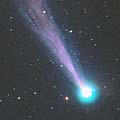
|
It was 6 mag, brighter than expected, in late September. Then it brightened furthermore in early October up to 5.5 mag (Oct. 6, Jose Carvajal). Very strongly condensed and easy to see. It keeps 6-7 mag until the end of October. In the Northern Hemisphere, it had been locating low in the morning sky, but it turns to locate in the evening sky after this. Then it keeps observable in the evening sky until early January while fading gradually. In the Southern Hemisphere, it cannot be observable until next April when it becomes fainter than 15 mag.
Date(TT) R.A. (2000) Decl. Delta r Elong. m1 Best Time(A, h)
Oct. 7 12 48.05 35 59.5 1.202 0.799 41 6.4 4:35 (231, 8)
Oct. 14 13 51.90 38 27.6 1.083 0.837 47 6.4 18:51 (126, 17)
|
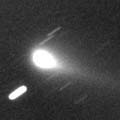
|
Now it is 10.7 mag (Oct. 6, Jakub Cerny). It is somewhat fainter than this ephemeris, however, it is well condensed and easy to see. The long dust tail is clearly visible. It will reach to 9 mag until winter, and observable in its best condition. It keeps 14 mag still in 2007 March, so it keeps visible visually for a long time.
Date(TT) R.A. (2000) Decl. Delta r Elong. m1 Best Time(A, h)
Oct. 7 2 7.36 11 47.8 0.740 1.713 159 9.6 1:06 ( 0, 67)
Oct. 14 2 8.65 10 21.5 0.712 1.699 166 9.4 0:40 ( 0, 65)
|
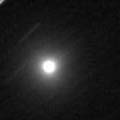
|
New comet discovered visually very near by Saturn. It is very bright, 9.4 mag on Oct. 5 (Juan Jose Gonzalez). But it was fainter than 12 mag in the photo on Sept. 30 (Tetuo Kudo). Probably, it brightened rapidly in early October. It is a short periodic comet with a period of 5.4 years. It may be one of the faint NEOs usually. The comet will be fading gradually after this. But it may fade out rapidly. It keeps locating in the morning sky until winter, then it keeps locating observable until next summer. But in the Northern Hemisphere, it becomes low in the south in 2007.
Date(TT) R.A. (2000) Decl. Delta r Elong. m1 Best Time(A, h)
Oct. 7 9 55.04 12 56.8 1.350 0.992 47 9.6 4:35 (274, 28)
Oct. 14 10 20.98 8 21.4 1.373 0.996 46 9.7 4:40 (279, 27)
|
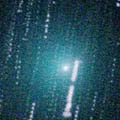
|
Recovered after 117 year blank since 1889. It brightened rapidly in mid July and reached to 8 mag. Then it kept bright at 8 mag with a large diffuse coma until early September. But it has already started fading. Now it is 10.5 mag (Oct. 6, Maciej Reszelski). It will fade out rapidly after this. Because it is very diffuse, it can be invisible soon. In the Northern Hemisphere, it keeps locating very high in the evening sky for a long time after this. It moves around the Northern Pole, so it will be observable all night until November, although it becomes low in the morning.
Date(TT) R.A. (2000) Decl. Delta r Elong. m1 Best Time(A, h)
Oct. 7 19 32.65 72 52.8 0.651 1.269 98 11.0 19:00 (177, 52)
Oct. 14 20 35.61 73 19.7 0.671 1.324 103 11.6 19:08 (180, 52)
|
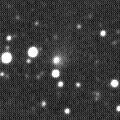
|
It is bright as 12.6 mag and visible visually (June 21, Juan Jose Gonzalez). It becomes too low in the evening to observe in October. But it will be getting higher in the morning sky after December. It keeps 13 mag until 2007 March, so it will be visible visually for a long time.
Date(TT) R.A. (2000) Decl. Delta r Elong. m1 Best Time(A, h)
Oct. 7 14 53.15 2 57.0 2.845 2.065 31 12.9 19:00 ( 85, 12)
Oct. 14 15 0.83 4 17.2 2.859 2.045 29 12.9 18:51 ( 88, 11)
|

|
A small outburst occured in late August, and it was visible visually, bright and strongly condensed, in early September. It is visible at 13.4 mag still now (Sept. 27, Seiichi Yoshida). Since it appeared in the morning sky in early July, it has been bright as 13 mag and visible visually. It is observable in good condition until winter.
Date(TT) R.A. (2000) Decl. Delta r Elong. m1 Best Time(A, h)
Oct. 7 4 24.13 31 42.7 5.234 5.845 123 13.3 3:23 ( 0, 87)
Oct. 14 4 22.71 31 48.1 5.150 5.847 130 13.3 2:54 ( 0, 87)
|
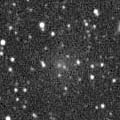
|
It will pass only 0.17 A.U. from the sun in 2007 January. Althohgh it was reported as 17 mag at the discovery, it is actually much brighter. Now it is 12.5-13 mag (Sept. 23, Michael Jager and Gerald Rhemann), with a very large diffuse coma of 2-2.5 arcmin. The comet will be brightening gradually after this, but it keeps locating low in the evening in the Northern Hemisphere. It will be observable only until early November when it becomes 12 mag. It is expected to reach up to 4.5 mag in January, but it is not observable at that time. After the perihelion passage, it is only observable in the Southern Hemisphere. In the Southern Hemisphere, it will appear at 8 mag in late January, then it keeps observable while fading gradually.
Date(TT) R.A. (2000) Decl. Delta r Elong. m1 Best Time(A, h)
Oct. 7 16 26.48 -14 41.2 2.609 2.178 54 14.0 19:00 ( 56, 19)
Oct. 14 16 30.48 -14 27.4 2.593 2.066 48 13.7 18:51 ( 59, 16)
|

|
It has been lost since its discovery in 1986. The condition is good in this return. In calculation, it was expected to be 14 mag from autumn to winter. But actually, it must be much fainter than expected. Although it has been listed up as an observable target since May, it has not been recovered yet. It was probably in outburst and brightened unexpectedly at the discovery. In the Northern Hemisphere, it keeps observable until it fades out in next spring. When it becomes brightest in October and November, it will move away from the Milky Way. So it will be easier to recover.
Date(TT) R.A. (2000) Decl. Delta r Elong. m1 Best Time(A, h)
Oct. 7 18 40.85 -21 48.1 1.190 1.499 85 14.0 19:00 ( 22, 30)
Oct. 14 18 58.52 -21 22.8 1.209 1.473 83 13.9 18:51 ( 22, 30)
|
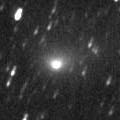
|
It reached up to 10.3 mag on July 7 (Juan Jose Gonzalez). Then it is fading gradually. Now it is 12.6 mag (Sept. 27, Seiichi Yoshida). In the Northern Hemisphere, it will get higher gradually after this. However, it will be too faint to see visually soon.
Date(TT) R.A. (2000) Decl. Delta r Elong. m1 Best Time(A, h)
Oct. 7 20 40.54 -32 27.3 1.349 1.934 109 14.1 19:37 ( 0, 23)
Oct. 14 20 51.37 -31 1.3 1.447 1.970 105 14.4 19:21 ( 0, 24)
|
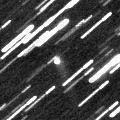
|
Now it is 14.3 mag and almost asteroidal (Sept. 20, Edwin van Dijk). Although the slight cometary activity was detected in late July, its faint tail became too hard to detect now. In the Northern Hemisphere, it keeps good condition after this. It keeps locating high until next spring. If it keeps asteroidal after this, it will be 13.7 mag at best. However, it may suddenly become active and brighten rapidly someday.
Date(TT) R.A. (2000) Decl. Delta r Elong. m1 Best Time(A, h)
Oct. 7 20 55.36 29 42.7 0.980 1.713 119 14.3 19:51 ( 0, 85)
Oct. 14 20 47.01 30 15.6 0.974 1.651 113 14.3 19:15 ( 0, 85)
|
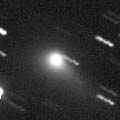
|
It had been observed at 10 mag in the evening sky from winter to spring. Although it has been unobservable since May, now it is appearing in the morning sky again. Now it is 14.0 mag (Sept. 25, Jakub Cerny), still visible visually.
Date(TT) R.A. (2000) Decl. Delta r Elong. m1 Best Time(A, h)
Oct. 7 9 35.26 25 42.7 3.682 3.238 56 14.3 4:35 (263, 38)
Oct. 14 9 42.11 25 15.2 3.663 3.307 61 14.4 4:40 (267, 44)
|
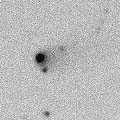
|
It has been visible at 13.5 mag for a long time since last autumn until spring. Although it had been unobservable for a while, now it is appearing in the morning sky again. It will be observable in good condition again at 14.5 mag in winter.
Date(TT) R.A. (2000) Decl. Delta r Elong. m1 Best Time(A, h)
Oct. 7 12 5.07 26 27.9 6.168 5.364 33 14.4 4:35 (244, 9)
Oct. 14 12 11.69 25 47.1 6.139 5.377 37 14.4 4:40 (248, 14)
|

|
It was missed in 1999 due to the bad condition. The condition is good in this return. It will reach to 13.5 mag in November. Although it is too low in the Northern Hemisphere now, it locates high in the Southern Hemisphere. It must be already bright as 15 mag, but it has not been recovered yet. In the Northern Hemisphere, it will be getting higher gradually after mid October.
Date(TT) R.A. (2000) Decl. Delta r Elong. m1 Best Time(A, h)
Oct. 7 18 33.23 -45 40.8 0.885 1.255 83 14.7 19:00 ( 15, 7)
Oct. 14 18 57.67 -43 54.4 0.866 1.218 81 14.5 18:51 ( 15, 9)
|
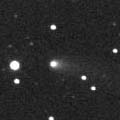
|
It is bright as 13.2 mag and visible visually (Sept. 27, Seiichi Yoshida). It keeps locating at the same altitude until December. But it will be too faint to see visually in October.
Date(TT) R.A. (2000) Decl. Delta r Elong. m1 Best Time(A, h)
Oct. 7 22 7.43 -23 23.2 2.602 3.345 131 15.1 21:03 ( 0, 32)
Oct. 14 22 6.65 -23 3.3 2.692 3.358 124 15.2 20:35 ( 0, 32)
|

|
It is observable in good condition at 15 mag in September and October.
Date(TT) R.A. (2000) Decl. Delta r Elong. m1 Best Time(A, h)
Oct. 7 1 8.89 71 16.4 0.537 1.313 113 15.2 0:13 (180, 53)
Oct. 14 0 5.98 62 55.9 0.576 1.401 123 15.3 22:31 (180, 63)
|

|
Appearing at dawn. Although it has not been observed since June, it must be already bright as 15.5 mag. It will reach to 14 mag in November and December, when it will be observable in excellent condition and visible visually. Then it keeps observable until February when it becomes fainter than 18 mag in the Northern Hemisphere.
Date(TT) R.A. (2000) Decl. Delta r Elong. m1 Best Time(A, h)
Oct. 7 10 5.09 -1 28.6 2.071 1.475 41 15.6 4:35 (285, 18)
Oct. 14 10 4.59 0 4.0 1.930 1.468 48 15.4 4:40 (289, 25)
|
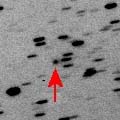
|
Now it is 16.5 mag (Sept. 2, Ken-ichi Kadota). It keeps 16 mag until December. It keeps observable until February when it becomes fainter than 18 mag.
Date(TT) R.A. (2000) Decl. Delta r Elong. m1 Best Time(A, h)
Oct. 7 8 54.35 15 15.9 1.803 1.596 61 15.6 4:35 (281, 42)
Oct. 14 9 10.68 12 47.5 1.768 1.608 64 15.6 4:40 (287, 44)
|

|
It was in major outburst unexpectedly and reached to 10.5 mag in its last appearance in 1999. It was already recovered in 2005 October. But it has not been observed for 1 year since that. So the current brightness is quite uncertain. It has already appeared in the morning sky. It is expected to be 15.5 mag, but actually, it can be much fainter than this ephemeris. It will fade out gradually after this.
Date(TT) R.A. (2000) Decl. Delta r Elong. m1 Best Time(A, h)
Oct. 7 10 51.97 9 3.9 2.588 1.828 32 15.6 4:35 (269, 14)
Oct. 14 11 7.44 7 3.0 2.570 1.848 35 15.7 4:40 (273, 17)
|
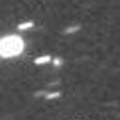
|
It is outside of Jupiter's orbit, so it keeps observable for a long time. Now it is 15.8 mag (June 2, Ernesto Guido and Giovanni Sostero). In 2006, it is still faint and locating somewhat low. But in 2007 and 2008, it is expected to be bright as 14.5-15 mag. It will locate high at that time, so it may be visible visually.
Date(TT) R.A. (2000) Decl. Delta r Elong. m1 Best Time(A, h)
Oct. 7 18 33.34 -21 20.8 6.540 6.516 84 15.8 19:00 ( 24, 30)
Oct. 14 18 32.18 -21 3.1 6.640 6.491 77 15.8 18:51 ( 29, 28)
|
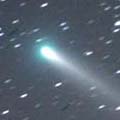
|
It reached to 6 mag at best in early May at the remarkable approach to the earth, when it became double naked eye comets with the component B around the zenith. Now it is going away from the earth and fading. It has already faded down to 13.9 mag (Sept. 27, Seiichi Yoshida). It will be too faint to see visually soon. The component B has faded out rapidly since June, and already so faint, fainter than 17 mag.
Date(TT) R.A. (2000) Decl. Delta r Elong. m1 Best Time(A, h)
Oct. 7 1 0.26 -16 24.4 0.878 1.844 158 16.0 0:00 ( 0, 39)
Oct. 14 0 50.09 -15 44.9 0.955 1.908 155 16.5 23:17 ( 0, 39)
|
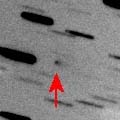
|
It was expected to reach to 13 mag in winter. But actually, it was still so faint as 17.6 mag on Sept. 23 (Ken-ichi Kadota), much fainter than expected. It will brighten rapidly in the morning sky after this. It will be observable in an excellent condition in November and December. However, it may be 14.5 mag at best, or even fainter.
Date(TT) R.A. (2000) Decl. Delta r Elong. m1 Best Time(A, h)
Oct. 7 6 37.03 6 22.6 1.264 1.661 93 16.4 4:35 (331, 58)
Oct. 14 6 50.53 7 52.0 1.188 1.645 97 16.1 4:40 (339, 61)
|
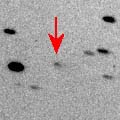
|
It becomes brightest about 4 months after the perihelion passage. It brightened up to 16.7 mag in mid September. It will reach to 15.5 mag and will be observable in good condition from November to January.
Date(TT) R.A. (2000) Decl. Delta r Elong. m1 Best Time(A, h)
Oct. 7 5 48.60 15 6.4 1.393 1.927 106 16.4 4:35 (351, 70)
Oct. 14 5 55.54 15 5.4 1.346 1.945 111 16.2 4:26 ( 0, 70)
|

|
Appearing at dawn. Although it has not been observed since April, it must be already bright as 16.5 mag. It is observable at 15.5-16 mag until next spring. But, in the Northern Hemisphere, it locates somewhat low at 20-30 degree high.
Date(TT) R.A. (2000) Decl. Delta r Elong. m1 Best Time(A, h)
Oct. 7 8 35.13 -17 37.7 4.450 4.099 63 16.4 4:35 (313, 22)
Oct. 14 8 33.38 -19 4.7 4.330 4.081 69 16.3 4:40 (322, 26)
|
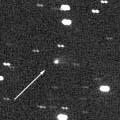
|
It kept 16.5 mag for a year and a half since early 2005. Now it is at opposition and observable in very good condition. However, it will start fading after November, and will be fainter than 18 mag at the end of 2006.
Date(TT) R.A. (2000) Decl. Delta r Elong. m1 Best Time(A, h)
Oct. 7 23 55.85 41 15.8 3.010 3.848 142 16.5 22:51 (180, 84)
Oct. 14 23 49.32 38 42.0 3.035 3.884 143 16.6 22:17 (180, 86)
|
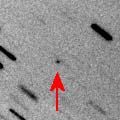
|
Although it was so faint as 20.7 mag on Aug. 2 (P. Birtwhistle), it brightened up to 17.9 mag on Sept. 18 (Ken-ichi Kadota). The condition of this apparition is excellent. It will brighten furthermore rapidly after this, and it is expected to reach to 16.5 mag in October and November.
Date(TT) R.A. (2000) Decl. Delta r Elong. m1 Best Time(A, h)
Oct. 7 4 41.01 27 16.2 0.699 1.485 120 16.9 3:39 ( 0, 82)
Oct. 14 4 51.30 32 15.5 0.659 1.474 124 16.7 3:22 ( 0, 87)
|

|
Peculiar asteroid moving along an orbit like a comet. It is at opposition in October. It will reach to 16.5 mag and will be observable in excellent condition.
Date(TT) R.A. (2000) Decl. Delta r Elong. m1 Best Time(A, h)
Oct. 7 1 10.59 -1 59.5 1.396 2.388 171 16.7 0:10 ( 0, 53)
Oct. 14 1 7.17 -3 16.6 1.372 2.358 168 16.7 23:35 ( 0, 52)
|

|
It was observed at 17 mag in spring. It will be observable in good condition at 17 mag again in autumn. It will be fainter than 18 mag in December.
Date(TT) R.A. (2000) Decl. Delta r Elong. m1 Best Time(A, h)
Oct. 7 5 12.00 11 47.5 1.509 2.133 114 16.7 4:11 ( 0, 67)
Oct. 14 4 48.17 7 46.7 1.428 2.183 127 16.7 3:20 ( 0, 63)
|
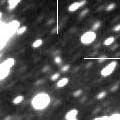
|
It keeps 17 mag for a long time after this until the end of 2007. It will be observable in good condition in 2006 autumn and 2007 autumn.
Date(TT) R.A. (2000) Decl. Delta r Elong. m1 Best Time(A, h)
Oct. 7 19 32.19 42 32.5 3.414 3.743 101 16.9 19:00 (143, 80)
Oct. 14 19 37.38 41 27.6 3.429 3.724 99 16.9 18:51 (130, 79)
|
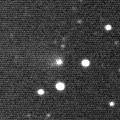
|
It was bright as 15 mag in 2004 and 2005. Now it is far away from the sun, but it is still observed at 17 mag in 2006.
Date(TT) R.A. (2000) Decl. Delta r Elong. m1 Best Time(A, h)
Oct. 7 0 49.51 -16 25.8 3.167 4.112 158 17.1 23:45 ( 0, 39)
Oct. 14 0 44.93 -16 38.1 3.208 4.129 154 17.2 23:12 ( 0, 38)
|
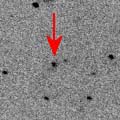
|
It is outside of Jupiter's orbit. So it keeps 16.5-17.5 mag for a long time until 2008. In 2006, it keeps observable in good condition until November.
Date(TT) R.A. (2000) Decl. Delta r Elong. m1 Best Time(A, h)
Oct. 7 20 38.64 -13 41.9 5.700 6.187 114 17.2 19:35 ( 0, 41)
Oct. 14 20 35.50 -13 20.8 5.800 6.171 107 17.2 19:04 ( 0, 42)
|
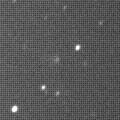
|
It reached up to 16 mag in 2005 summer in the Southern Hemisphere. It was 16.6 mag on Sept. 19 (Mitsunori Tsumura), a bit brighter than this ephemeris. It will keep 17.5 mag until January after this. Then it will be fainter than 18 mag in February.
Date(TT) R.A. (2000) Decl. Delta r Elong. m1 Best Time(A, h)
Oct. 7 5 49.78 -22 57.0 4.410 4.713 101 17.3 4:35 (356, 32)
Oct. 14 5 48.74 -23 11.1 4.370 4.749 106 17.3 4:20 ( 0, 32)
|

|
It keeps 17.5 mag until November. Then it fades out soon.
Date(TT) R.A. (2000) Decl. Delta r Elong. m1 Best Time(A, h)
Oct. 7 1 36.14 -15 30.9 2.242 3.182 156 17.3 0:36 ( 0, 39)
Oct. 14 1 28.66 -14 52.2 2.254 3.196 156 17.3 0:01 ( 0, 40)
|
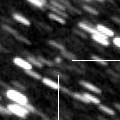
|
It will reach to 14.5 mag in 2007 summer, but it will be observable only in the Southern Hemisphere at that time. Now it is 17.2 mag (Aug. 27, J. Young). In the Northern Hemisphere, it keeps observable at 17.5 mag in good condition until autumn.
Date(TT) R.A. (2000) Decl. Delta r Elong. m1 Best Time(A, h)
Oct. 7 19 23.27 -2 1.8 4.748 4.989 98 17.4 19:00 ( 16, 52)
Oct. 14 19 22.22 -3 14.9 4.820 4.943 91 17.4 18:51 ( 23, 49)
|

|
It was observed at 17 mag in 2005 summer. It will reach to 17 mag again in 2006 summer. However, no observations have been reported yet in 2006.
Date(TT) R.A. (2000) Decl. Delta r Elong. m1 Best Time(A, h)
Oct. 7 22 18.93 -14 58.8 2.588 3.393 137 17.4 21:15 ( 0, 40)
Oct. 14 22 17.91 -15 8.5 2.672 3.404 130 17.5 20:46 ( 0, 40)
|
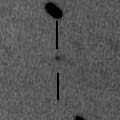
|
The perihelion passage is in 2008. It will be observable for several years after this at around 17 mag. But it may fade out rapidly just after the perihelion passage.
Date(TT) R.A. (2000) Decl. Delta r Elong. m1 Best Time(A, h)
Oct. 7 4 55.05 10 59.3 4.282 4.847 119 17.5 3:54 ( 0, 66)
Oct. 14 4 54.48 10 54.0 4.181 4.835 125 17.5 3:26 ( 0, 66)
|
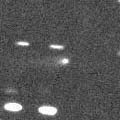
|
It was observed at 17 mag in late 2005. In 2006 autumn, it became observed again. It will be observable at 17.5 mag in good condition until November.
Date(TT) R.A. (2000) Decl. Delta r Elong. m1 Best Time(A, h)
Oct. 7 2 8.42 23 29.1 4.515 5.430 153 17.5 1:08 ( 0, 79)
Oct. 14 1 58.40 22 57.6 4.489 5.445 161 17.5 0:31 ( 0, 78)
|

|
It reached to 6 mag in 2004. It had been visible visually until January. It has already faded down to 17.2 mag (Aug. 9, Ken-ichi Kadota). It will be fading slowly around 17-18 mag until December.
Date(TT) R.A. (2000) Decl. Delta r Elong. m1 Best Time(A, h)
Oct. 7 2 49.46 -3 23.3 7.099 7.971 148 17.5 1:49 ( 0, 52)
Oct. 14 2 45.40 -3 41.8 7.114 8.027 154 17.5 1:17 ( 0, 51)
|

|
It keeps 17 mag until January. Then it keeps observable util April when it becomes fainter than 18 mag.
Date(TT) R.A. (2000) Decl. Delta r Elong. m1 Best Time(A, h)
Oct. 7 4 51.69 47 32.7 3.384 3.893 113 17.6 3:50 (180, 77)
Oct. 14 4 52.21 48 26.7 3.299 3.885 119 17.5 3:24 (180, 77)
|
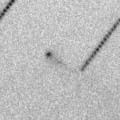
|
New comet. It was discovered because it passed very close by Earth. Howver, because it is very small, it will fade out very rapidly.
Date(TT) R.A. (2000) Decl. Delta r Elong. m1 Best Time(A, h)
Oct. 7 23 54.62 15 55.3 0.440 1.426 162 17.8 22:51 ( 0, 71)
Oct. 14 0 3.92 12 50.5 0.471 1.452 161 18.0 22:33 ( 0, 68)
|
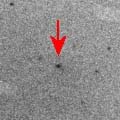
|
It will be fainter than 18 mag soon.
Date(TT) R.A. (2000) Decl. Delta r Elong. m1 Best Time(A, h)
Oct. 7 23 19.71 -5 17.6 1.758 2.698 155 17.8 22:15 ( 0, 50)
Oct. 14 23 16.66 -4 55.9 1.829 2.725 147 18.0 21:45 ( 0, 50)
|

|
Peculiar asteroid moving along an orbit like a comet. It was observed at 17 mag in February and March. It will be observable at 17 mag again in October and November. But it will fade out soon.
Date(TT) R.A. (2000) Decl. Delta r Elong. m1 Best Time(A, h)
Oct. 7 5 18.29 39 8.5 1.608 2.177 111 18.1 4:18 (180, 86)
Oct. 14 4 46.17 39 20.4 1.501 2.214 123 17.9 3:19 (180, 86)
|

|
It is observable at 18 mag in 2006 autumn. It will reach to 15 mag two years later.
Date(TT) R.A. (2000) Decl. Delta r Elong. m1 Best Time(A, h)
Oct. 7 2 28.11 8 24.1 3.604 4.532 155 17.9 1:27 ( 0, 63)
Oct. 14 2 24.43 8 6.2 3.563 4.526 162 17.9 0:56 ( 0, 63)
|
|
![]()
 71P/Clark
71P/Clark P/2006 HR30 ( Siding Spring )
P/2006 HR30 ( Siding Spring ) C/2005 E2 ( McNaught )
C/2005 E2 ( McNaught ) C/2003 WT42 ( LINEAR )
C/2003 WT42 ( LINEAR ) P/1991 V1 ( Shoemaker-Levy 6 )
P/1991 V1 ( Shoemaker-Levy 6 ) 117P/Helin-Roman-Alu 1
117P/Helin-Roman-Alu 1 (3200) Phaethon
(3200) Phaethon C/2006 L1 ( Garradd )
C/2006 L1 ( Garradd ) 114P/Wiseman-Skiff
114P/Wiseman-Skiff 52P/Harrington-Abell
52P/Harrington-Abell C/2005 L3 ( McNaught )
C/2005 L3 ( McNaught ) 73P-C/Schwassmann-Wachmann 3
73P-C/Schwassmann-Wachmann 3 76P/West-Kohoutek-Ikemura
76P/West-Kohoutek-Ikemura 84P/Giclas
84P/Giclas C/2005 EL173 ( LONEOS )
C/2005 EL173 ( LONEOS ) C/2005 B1 ( Christensen )
C/2005 B1 ( Christensen ) 112P/Urata-Niijima
112P/Urata-Niijima 2006 QL39
2006 QL39 C/2006 CK10 ( Catalina )
C/2006 CK10 ( Catalina ) C/2006 M1 ( LINEAR )
C/2006 M1 ( LINEAR ) P/2004 F3 ( NEAT )
P/2004 F3 ( NEAT ) C/2005 S4 ( McNaught )
C/2005 S4 ( McNaught ) C/2004 L2 ( LINEAR )
C/2004 L2 ( LINEAR ) P/2006 S4 ( Christensen )
P/2006 S4 ( Christensen ) C/2006 K4 ( NEAT )
C/2006 K4 ( NEAT ) P/2005 L1 ( McNaught )
P/2005 L1 ( McNaught ) 173P/2005 T1 ( Mueller 5 )
173P/2005 T1 ( Mueller 5 ) C/2005 R4 ( LINEAR )
C/2005 R4 ( LINEAR ) C/2003 K4 ( LINEAR )
C/2003 K4 ( LINEAR ) P/2005 SB216 ( LONEOS )
P/2005 SB216 ( LONEOS ) P/2006 S1 ( Christensen )
P/2006 S1 ( Christensen ) P/2006 H1 ( McNaught )
P/2006 H1 ( McNaught ) 2006 BZ8
2006 BZ8 74P/Smirnova-Chernykh
74P/Smirnova-Chernykh![]()




























